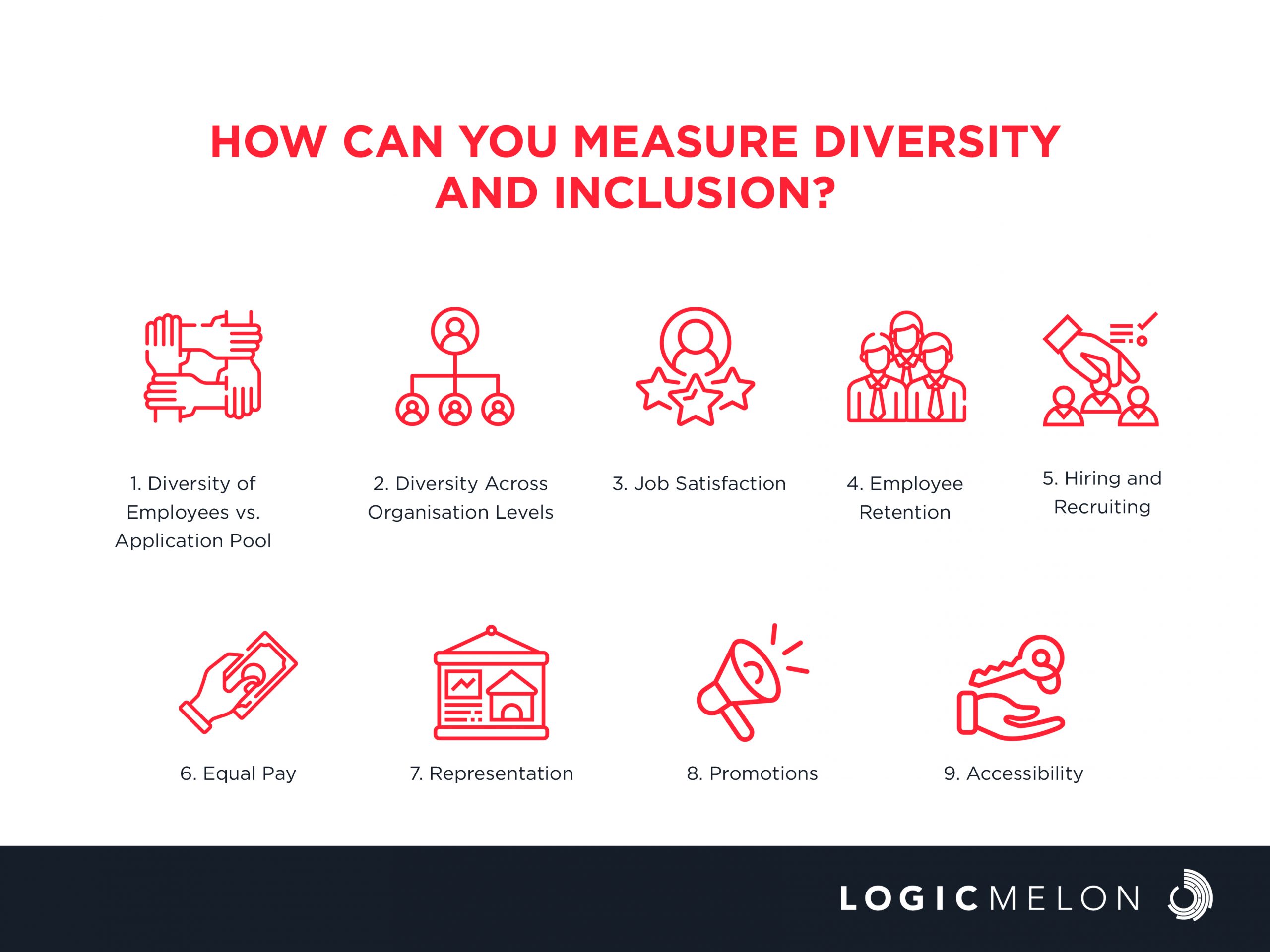9 Diversity Metrics You Should Track in Your Organisation
Diversity metrics are the measurable numerical values that help top-level management see workforce demographics and assess the efforts of the company toward inclusive practices.
Diversity has so many different dimensions, including age, gender, and race. It’s difficult to know exactly what to measure and the same goes with inclusion. Diversity can be defined as the traits or characteristics of an individual. The benefit of workplace diversity is that it can help to improve communication within the company. Diversity metrics help to measure diversity and to build them in the organisation.
What Are DEI Metrics?
DEI metrics are an indicator of the state of Diversity, Equity, and Inclusion efforts at your organisation. These metrics help to measure diversity because people build a stronger sense of identity and well-being.
Inclusion is the practice of ensuring that people feel a sense of belonging in the workplace. Inclusion in the workplace is an important key to retention because, when employees do not feel that their ideas, presence, or contributions are truly valued or taken seriously by their organisation, they may eventually leave.
Equity is the process of ensuring that practices and programs are impartial, fair, and provide equal possible outcomes for every individual.
How Can You Measure Diversity and Inclusion?

1. Diversity of Employees vs. Application Pool
By measuring how many people from different backgrounds make their way from the candidate pool to receiving a job offer, you can reveal the trends in hiring that may be indicative of unconscious bias. Ideally, your hires should generally reflect the diversity of applicants.
2. Diversity Across Organisation Levels
For diversity to actually have an impact, it needs to be at all levels of an organisation, from technicians to managers and key decision-makers. These include promotions, parity in performance reviews, and access to additional training, development, and mentoring programs.
There are numerous ways to measure how people progress through an organisation. Diversity is only meaningful when everyone has equal opportunity to grow and succeed.
3. Job Satisfaction
This is one of the most challenging metrics to track, but it is vital for understanding whether certain groups of employees feel valued, motivated, and supported.
Evaluating an organisation as a whole and analysing these results based on diversity criteria may reveal a pattern of bias. These patterns have a profound effect on how different groups of people may experience your workplace.
4. Employee Retention
This is about measuring the average retention period and comparing it across commonalities, such as gender and ethnicity. This can be supplemented by qualitative information about how engaged employees are, and what their reasons might be for leaving the organisation.
Surveys and third parties can help ensure anonymity regarding feedback, and employee exit interviews can be tailored to include questions about inclusivity, compare culture and diversity, and gain targeted feedback.
5. Hiring and Recruiting
Diversity in the hiring process can increase your workforce’s range of skills and abilities and is vital in expanding the customer base. Reaching out to more customers means more opportunities to increase sales.
Diversity of the hiring panel gets interviews of varying demographics, like age, gender, race, and level of skills and experience. It helps to make diverse applicants feel comfortable because they can relate to one of those interviewers with the same background.
6. Equal Pay
Looking at the pay disparities within your organisation can help to uncover a lot of potential issues with your pay practices, and design solutions for them. There is generally a sentiment that people from different demographic groups are compensated differently for doing the same work.
7. Representation
Representation not only gives a voice to those who were previously underrepresented, but it also gives hope for all the employees to learn about people they might not understand, or who are different from them.
When you bring diversity and representation into the mix, you get views from various ethnic backgrounds, religious beliefs, and levels of society. To improve your diversity representation across your organisation, you can start by implementing DEI employee surveys. Doing this can help discover missing or specific groups from entry-level to leadership positions.
8. Promotions
To find out if there is any inequality in career advancement options, track promotion applications across demographics that is gender, race, and educational background. Monitor the time it takes each group to get promoted. Also, compare the learning and development opportunities per segment.
9. Accessibility
Accessibility is one of those considerations that companies must follow, but at the same time, due to a lack of representation or understanding, they often do not fully consider it. The HR team should also satisfy the needs of disabilities, and must specifically consider the products, services, and facilities that are built or modified so that they can be used by people of all abilities.
Frequently Asked Questions (FAQs)
1. What do you mean by metrics?
Metrics are the numbers that tell you important information about a process under question. They tell you accurate measurements about how the process is functioning and can provide a base for you to suggest improvements.
2. What is DEI?
DEI stands for diversity, equity, and inclusion, and has the potential to increase sales revenue, increase the customer base, and ultimately increase profits.
3. Why are DEI metrics important?
DEI metrics are an indicator of the state of diversity, equity, and inclusion efforts at your organisation. It helps your organisation assess the DEI outcomes and progress to achieve its objectives.
4. How do you measure equity in the workplace?
Equity is challenging to measure, so a place to start could be to measure perceptions. Achieving equity and creating a fair workplace have clear business benefits.
Closing Thoughts
Diversity has the potential to increase the customer base by attracting customers from different backgrounds, ethnicities, and values. Valuing the differences of others is what brings everyone together, and can be the secret to a successful, thriving workplace and a fair work culture. The range of experience, expertise, and working methods that a diverse workplace offers can boost problem-solving capacity and lead to greater productivity.
The diversity metrics are measured by comparing the diversity of employees to the application pool, diversity across all organisation levels, job satisfaction, employee retention, hiring and recruiting, equal pay, representation, promotion, and accessibility.
LogicMelon
Award-winning recruitment software that will find, attract, hire and analyse the way you want to work. At LogicMelon, we have experienced software recruitment marketing specialists to help you build effective recruitment solutions supported by the best customer service you’ll find anywhere!
Email: sales@logicmelon.com or call LogicMelon (UK) +44 (0) 203 553 3667 (USA) +1 860 269 3089
What is a Hybrid Organisational Structure?
Employees are required to work on many projects and report to multiple managers under the hybrid organisational structure.
Maximising the Effectiveness of Your Recruitment Website: Key Considerations
Your recruitment website serves as more than just a digital business card. Read the blog to know more.
Cloud Onboarding: Your Roadmap to Digital Transformation
Cloud onboarding is a strategic onboarding process that organisations undertake to successfully transition to cloud computing environments.


